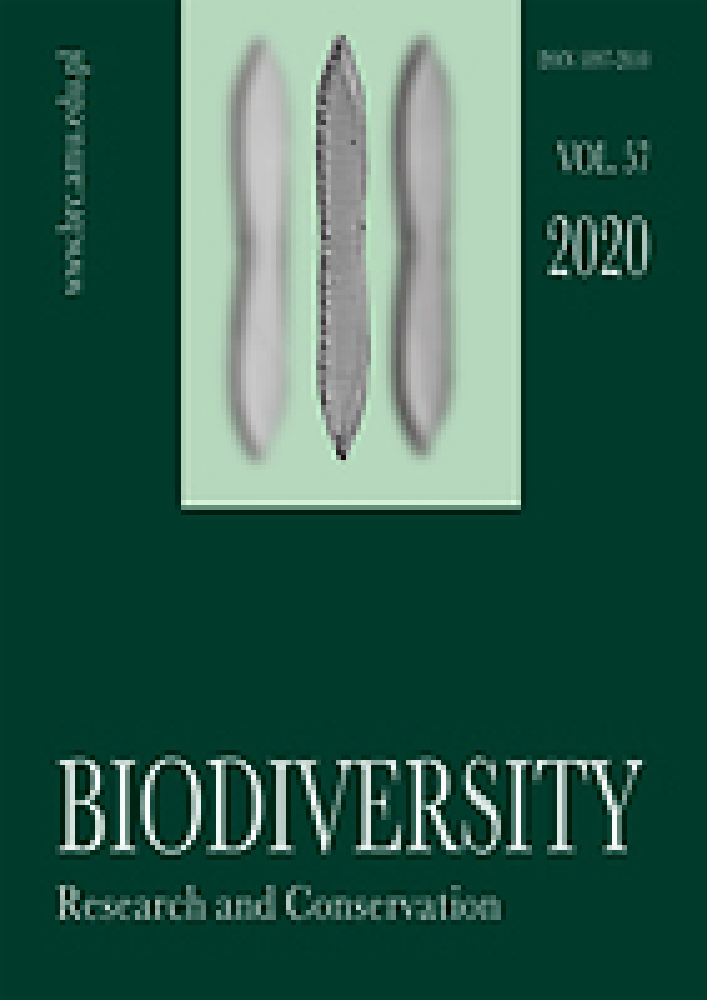Abstract
Nitzschia taikiensis sp. nov. is a brackish diatom species found in the Toberi River marsh, eastern Hokkaido, Japan. This species has characteristics similar to Nitzschia subamphioxoides Hustedt, which was originally described by Hustedt in 1959. In the present study, we conducted a comparative morphological analysis of N. taikiensis and N. subamphioxoides. The obtained results showed that they are different species. Sampling sites of N. taikiensis were located in salt marsh environments with very low salinity (1-5‰), acidic pH (5.2-5.9) and high mud content (95.0-97.5%). Identification of this species was relatively easy based on LM and SEM image analysis of its frustule features, such as the external form and stria density. This species has not been previously reported in Japan, which could be attributed to the reduction or loss of Japanese freshwater and salt marsh environments in the coastal areas, resulting from urban and industrial development.
References
Baruah P. P. & Kakati B. 2012. Water quality and Phytoplankton diversity of Gopeswar temple freshwater pond in Assam, India. Bangl J Bot 41(2): 181-185.
Chiba T. & Nishimura Y. 2018. Necessity to distinguish Neogene diatoms from living and dead assemblages at the Toberi river mouth area, Hokkaido, Japan: A strategy for the paleo-tsunami research. Abstract of Japan Geoscience Union Meeting 2018, MIS11-P03, https://confit.atlas.jp/guide/event-img/jpgu2018/MIS11-P03/public/pdf?type=in
Chiba T & Sawai Y. 2014. Reexamination and updating of diatom species for paleoenvironmental reconstructions. Diatom 30: 17-30 (in Japanese with English abstract).
Chiba T., Nishimura Y. & Ohtsuka T. 2018. Fossil diatom assemblages during the last millennium in the Toberi River mouth area, Hokkaido, Japan. Diatom 34: 8-29.
Denys L. & Lange-Bertalot H. 1998. Observations on two taxa of the section Nitzschiae Lanceolatae (Bacillariophyceae): Nitzschia blankaartensis sp. nov. and N. bulnheimiana. Nova Hedwigia 67(1-2): 247-58.
Genkal S. I. & Yarushina M. 2016. A study of flora of Bacillariophyta in water bodies and water courses of the Naduiyakha river basin (Yamal Peninsula, Russia). International Journal on Algae 18(1): 39-56.
Hamsher S., Kopalová J. K., Kociolek P., Zidarova R & Van De Vijver B. 2016. The genus Nitzschia on the South Shetland Islands and James Ross Island. Fottea, Olomouc 16: 79-102.
Hassall A. H. 1845. A history of the British Freshwater Algae, including descriptions of the Desmideae and Diatomaceae with upwards of one hundred plates. I. Text. S. Highley & N. Bailliere, 462 pp. London, Edinburgh, Paris & Leipzig.
Hustedt F. 1959a. Die Diatomeenflora des Salzlackengebietes im österreichischen Burgenland. Österreichischen Akademie der Wissenschaften, Mathematische und Naturwissenschaftliche, Kl. Abt. 1, 168: 387-452.
Hustedt F. 1959b. Die Diatomeenflora des Neusiedler Sees im österreichischen Burgenland. Österreichische Botanische Zeitschrift 106: 390-430.
Japanese Standards Association., 2000. JIS A1226: 2000 Test method for ignition loss of soils, Japanese Standards Association, Tokyo, Japan. (in Japanese) https://kikakurui.com/a1/A1226-2009-01.html
Kosugi M. 1985. Discrimination of living or dead cells of diatom based on the stained images – its method and significance. The Quaternary Research (Dai-Yonki Kenkyu) 24(2): 139-147 (in Japanese with English abstract).
Krammer K. & Lange-Bertalot H. 1988. Bacillariophyceae 2. Teil: Bacillariaceae, Epithemiaceae, Surirellaceae. In: H. Ettl, J. Gerloff, H. Heynig & D. Mollenhauer (eds.). Süβwasserflora von Mitteleuropa 2/2, 596 pp. Gustav Fischer, Jena.
Krivograd Klemenčič A., Vrhovšek D. & Smolar-Žvanut N. 2007. Microplanktonic and microbenthic algal assemblages in the coastal brackish Lake Fiesa and the Dragonja Estuary (Slovenia). Natura Croatica 16: 63-78.
Liu Q., Wu W., Wang J., Feng J., Lv J., Kociolek J. P. & Xie S. 2017. Valve ultrastructure of Nitzschia shanxiensis nom. nov., stat. nov. and N. tabellaria (Bacillariales, Bacillariophyceae), with comments on their systematic position. Phytotaxa 312(2): DOI: http://dx.doi.org/10.11646/phytotaxa.312.2.5
Löffler H. 1979. Neusiedlersee: the limnology of a shallow lake in central Europe. Monographiae Biologicae 37. 543 pp.1. Dr. W. Junk Publisher, The Hague.
Lowe R. L. 1974. Environmental requirements and pollution tolerance of freshwater diatoms. Environmental Protection Agency (EPA)_670/4-74-005: 333 pp. National Service Center for Environmental Publications, Cincinnati, OH.
Pinseel E., Van De Vijverbart B., Kavan J., Verleyen E. & Kopalová K. 2017. Diversity ecology and community structure of the freshwater littoral diatom flora from Petuniabukta (Spitsbergen). Polar Biol 40(3): 533-551.
Round F. E., Crawford R. M. & Mann D. G. 1990. The Diatoms: Biology and Morphology of the Genera, 747 pp. Cambridge University Press, Cambridge.
Sawai Y. 2001. Distribution of living and dead diatoms in tidal wetlands of northern Japan: relations to taphonomy. Palaeogeography, Palaeoclimatology, Palaeoecology 173(3-4): 125-141.
Sawai Y. 2014. Diatom fossil analysis as an aid for paleoseismology. Diatom 30: 57-74 (in Japanese with English abstract).
Simonsen R. 1987. Atlas and catalogue of the diatom types of Friedrich Hustedt. 1: 525 pp. Plate 3: 772 pp. J. Cramer, Berlin, Stuttgart.
Stoermer E. F. 1963. Post-Pleistocene diatoms from Lake West Okoboji, Iowa. 233 pp. Ph. D. thesis, Iowa State University.
Stoermer E. F., Kreis J. R. G. & Andresen N. A. 1999. Checklist of diatoms from the Laurentian Great Lakes, II. J Great Lakes Res 25(3): 515-566.
Takano S., Akaneya K., Watanabe T. & Katano K. 2009. Diatoms from Akita Prefecture, northern part of Japan, part II Diatoms from Toyokawa River. Diatom 25: 120-133 (in Japanese with English abstract).
Tani K. 2015. Development and algorithm of a Web site to draw contour lines of Japan using altitude tile data. Saitama University Department of Geography occasional paper 35: 20-31 (in Japanese with English abstract).
Van Dam H., Mertens A. & Sinkeldam J. 1994. A coded checklist and ecological indicator values of freshwater diatoms from the Netherlands. Netherlands Journal of Aquatic Ecology 28(1): 117-133.
Vos P.C. & De Wolf H. 1993. Diatoms as a tool for reconstructing sedimentary environments in coastal wetlands; methodological aspects. Hydrobiologia 269/270(1): 285-296.
Veres A. J., Pienitz R. & Smol J. P. 1995. Lake Water Salinity and Periphytic Diatom Succession in Three Subarctic Lakes Yukon Territory, Canada. Arctic 48(1): 63-70.
Witkowski A., Lange-Bertalot H. & Metzeltin D. 2000. Diatom Flora of Marine Coasts I. Iconographia Diatomologica 7, 925 pp. Koeltz Sci. Königstein.





